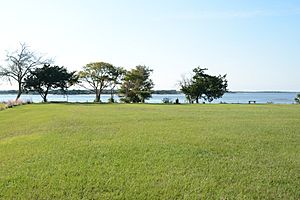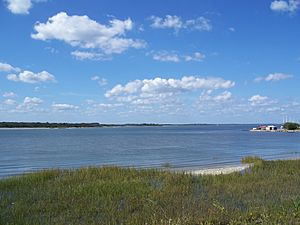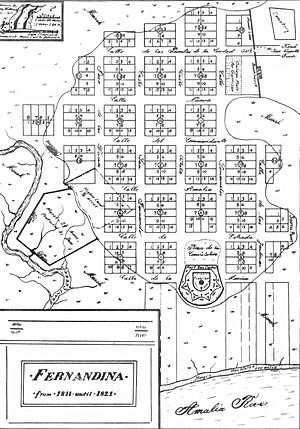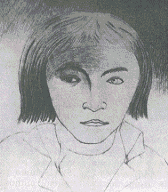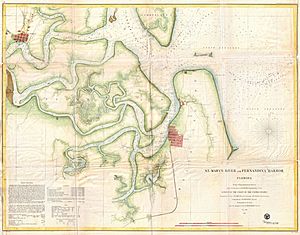Original Town of Fernandina Historic Site facts for kids
Quick facts for kids |
|
|
Original Town of Fernandina Historic Site
|
|
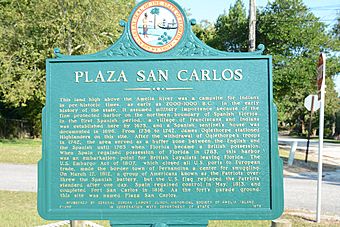
Plaza San Carlos marker at original Fernandina town site
|
|
| Location | Fernandina Beach, Florida |
|---|---|
| Built | 1811 |
| NRHP reference No. | 86003685 |
| Added to NRHP | January 29, 1990 |
The Original Town of Fernandina Historic Site, often called "Old Town", is a special historical place in Fernandina Beach, Florida. It's located on Amelia Island in Florida. This area was added to the U.S. National Register of Historic Places on January 29, 1990.
Before Europeans arrived, Native Americans lived here. Over the centuries, the French, English, and Spanish all spent time on Amelia Island. But it was the Spanish who officially started Fernandina. Old Town is unique because it was the very last Spanish city ever planned in the Western Hemisphere, back in 1811. Its design followed old Spanish rules called the "Law of the Indies."
A part of Old Town called Plaza San Carlos was once the open space in front of the Spanish Fort San Carlos. The fort is gone now, but the Plaza San Carlos is still there. It's now a state park where you can enjoy nature and have picnics.
Later, in 1861, David Levy Yulee, one of Florida's first U.S. senators, built a railroad. This railroad connected Fernandina Beach to Cedar Key. When he built it, Yulee decided to move the town of Fernandina to a new spot. This new spot is where downtown Fernandina Beach is today. Because of this move, Old Town became mostly a quiet neighborhood.
Experts have studied Old Town for many years. They've learned a lot about its Native American past and its exciting history. The city of Fernandina Beach now has rules to protect Old Town. These rules help make sure that new buildings fit in with the old Spanish design. Old Town celebrated its 200th birthday on April 2, 2011.
A Long History: From Native Americans to a British Base
The original town of Fernandina was built on a high piece of land. This land overlooks the Amelia River on the northwest side of Amelia Island. People have lived on this land for a very long time. Native Americans camped here as far back as 2000 to 1000 BC. The St. Johns People lived here, and later their descendants, the Timucua, used the same area.
The deep, safe harbor here was well-known to early European explorers. The Timucua people called the island Napoyca. The Spanish later called it "Santa María." Spanish Franciscan friars built a mission called Santa María de Sena by 1602. A Spanish guard post was also built here in 1696.
This spot became important for its harbor and its location near the border of Spanish Florida. From 1736 to 1742, the governor of the British colony of Georgia, James Oglethorpe, placed Scottish soldiers here. He named the island after Princess Amelia, the daughter of King George II of Great Britain.
The "New Settlement" and British Rule
Oglethorpe's troops left in 1742. The area then became a neutral zone between the English and Spanish. In 1763, Spain gave Florida to Great Britain in exchange for Havana, Cuba. During early British rule, the island was called Egmont Isle. This was after Lord Egmont, who owned most of the island.
The "New Settlement," which is today's Old Town, was likely his main base. Maps from the 1770s show houses and streets laid out here. Lord Egmont died in 1770, and his wife continued to develop the land. They grew indigo, a plant used to make blue dye, until it was destroyed by American rebel troops in 1776.
In the late 1770s, British loyalists escaping from Charleston and Savannah built new homes here. They called their town Hillsborough. When Spain got Florida back in 1783, many loyalists left. They even took their houses apart to use the wood elsewhere.
After the British left, Mary Mattair and her family were almost the only people left on Amelia Island. She had been given land by the British governor. The Spanish allowed her to stay. Her land grant became the site of Old Town Fernandina. In 1793, Mary Mattair's daughter married Domingo Fernandez, a Spanish harbor pilot.
In 1795, American rebels attacked the Spanish soldiers on Amelia Island. The Spanish military fought back and the rebels fled. Later, in the early 1800s, the U.S. government stopped trade with Europe. This made Fernandina a place where people smuggled goods like slaves, alcohol, and luxury items. The town was protected by soldiers and blockhouses.
Fernandina: A Spanish Town is Born
On January 1, 1811, the town of Fernandina was officially named. It was named after King Ferdinand VII of Spain. The governor of Spanish East Florida, Enrique White, chose the name. On May 10, 1811, the new governor, Juan José Estrada, ordered the town to be planned. This plan followed the old Spanish Laws of the Indies. These laws told how to choose a town site and how to lay out the streets. They set aside places for the fort, a parade ground, a church, and a cemetery. A main square, called Plaza de la Constitution, was placed near the river.
Fernandina was the last town ever planned using these old Spanish laws in the Western Hemisphere. It was meant to be a strong point against the United States expanding its territory. But in the years that followed, many different groups took control of the town. It became a busy place with many saloons.
The Patriots' War and U.S. Involvement
Because Fernandina was a center for smuggling, the United States saw it as a problem. In 1812, U.S. forces secretly invaded and took control of Fernandina. General George Mathews led this effort. He was secretly working for President James Madison. Mathews wanted to start a rebellion in Spanish East Florida.
A group of Americans called the "Patriots of Amelia Island" joined together. Most of them were Georgia soldiers. They wanted to remove the Spanish. They also wanted to stop attacks from Seminole Indians. And they were worried about armed free black militias in Spanish Florida.
On March 16, nine American gunboats lined up in the harbor. They pointed their guns at the town. General Mathews ordered the Spanish commander to surrender. The Spanish leader, Justo Lopez, saw he was outnumbered and gave up the town. On March 17, the Patriots raised their own flag. The next day, U.S. troops arrived. The Patriots then gave control of the town to General Mathews. He immediately raised the U.S. flag. The Patriots had held Fernandina for only 24 hours.
President Madison wanted to add East Florida to the United States. But Congress worried about starting a war with Spain. So, the plan fell apart. U.S. troops began to leave in early 1813. On May 6, the U.S. army lowered its flag and left Fernandina. Spain took control of the island again. The Spanish finished building the new Fort San Carlos in 1816 to protect the port.
Fort San Carlos was made of wood and earth. It had eight or ten cannons. The town had about 600 people and was growing fast. The old Native American campsite became the fort's parade ground. This area, and the original town layout, are still preserved today.
Gregor MacGregor and the "Republic of the Floridas"
As Spain's empire weakened, Fernandina became an easy target. A Scottish soldier named Gregor MacGregor arrived. He claimed to be helping South American countries fight for freedom from Spain. With money from American supporters, he led a small army of only 150 men. On June 29, 1817, he attacked Fort San Carlos. He had spies inside the fort who told him there were only 55 Spanish soldiers. MacGregor spread rumors that he had over 1,000 men. The Spanish commander believed the rumors and fled.
MacGregor raised his own flag, the "Green Cross of Florida," over the fort. He declared the "Republic of the Floridas." He quickly set up a government. He appointed Ruggles Hubbard as civil governor and Jared Irwin as treasurer. MacGregor opened a post office and even printed his own money. He hoped to conquer all of Spanish East Florida. But his plan failed. President James Monroe was trying to buy Florida from Spain, and MacGregor's actions made things difficult.
Soon, MacGregor ran out of money. To get funds, he sent out privateers. These were ships allowed to attack Spanish vessels. They would capture Spanish ships and their goods, often including slaves. These goods were then sold. When more help didn't arrive, MacGregor announced he was leaving. On September 4, he left Fernandina. He left a small group of men to defend the island. After he left, these men, along with American fighters, stopped the Spanish from taking back control.
The Battle of Amelia Island
On September 13, the Battle of Amelia Island began. The Spanish set up cannons on a hill east of the fort. They had about 300 men and two gunboats. They started firing at Fernandina, which was held by Jared Irwin's forces. Irwin had about 94 men and three privateer ships. The Spanish fired until dark. Their commander realized he couldn't capture the island and pulled back his forces.
Louis Aury and the Mexican Flag
Before leaving, MacGregor had met with a French privateer named Louis-Michel Aury. Aury sailed into Fernandina on September 17, 1817. He had a crew of 300, including American recruits and former slaves from Haiti. Aury demanded to be in charge of the government. Hubbard and Irwin agreed, as they needed money and troops. Aury became the military leader, and the flag of the revolutionary republic of Mexico was raised over Fort San Carlos. So, Amelia Island was briefly part of Mexico on September 21, 1817.
Florida Becomes Part of the United States
This new government in Fernandina didn't last long. Aury's privateers captured many Spanish goods. These activities made the U.S. government unhappy. President Monroe sent forces to take back Amelia Island. Aury realized he couldn't win and surrendered the island on December 23, 1817. The U.S. military took control of Fernandina.
Even though Spain was angry, they officially gave Florida to the United States in 1821. This was part of the Adams-Onis Treaty. The U.S. Army didn't use Fort San Carlos much and soon left it.
The Town of Fernandina Moves
In 1853, the town of Fernandina moved about a mile south. This happened because David Levy Yulee started his Florida Railroad. Fernandina was meant to be the end point of the railroad on the east coast. Yulee said the tracks couldn't cross the swampy land to Old Town. Also, Old Town wasn't big enough for his plans to build a major city. Construction began in 1855. The original site of Fernandina, once a busy place for smugglers and adventurers, became quiet. But the original Spanish town plan and street names are still there today.
During the American Civil War, Confederate soldiers used Fort San Carlos. Experts believe that two-thirds of the fort's original area has been lost due to erosion by the Amelia River. You can still see traces of the old fort and parade grounds along Estrada Street.
Images for kids


